the 2007 Abstract Presentations - Wound Healing Society
the 2007 Abstract Presentations - Wound Healing Society
the 2007 Abstract Presentations - Wound Healing Society
Create successful ePaper yourself
Turn your PDF publications into a flip-book with our unique Google optimized e-Paper software.
<strong>Abstract</strong>s<br />
49<br />
DEVELOPMENT OF A RAPID DNA APTAMER-BASED TEST<br />
STRIP TO ASSESS MOLECULAR PROFILES OF CHRONIC<br />
WOUNDS<br />
D.J. Gibson, J.B. Hill, C.D. Batich, W. Tan, G.S. Schultz<br />
University of Florida, Gainesville, FL USA<br />
Clinical assessment of chronic wounds is currently based primarily on visual<br />
assessments of <strong>the</strong> wound and surrounding tissue, which typically rely on <strong>the</strong><br />
appearance of devitalized tissue, and signs of inflammation, infection, and<br />
epi<strong>the</strong>lial cell migration from <strong>the</strong> wound edge. However, multiple reports have<br />
established <strong>the</strong>re are important molecular differences between healing and nonhealing<br />
wounds that contribute to <strong>the</strong> failure of wounds to heal, including<br />
elevated cytokines and proteases that degrade ECM proteins, growth factors and<br />
receptors that are essential for healing. Thus, <strong>the</strong>re is a need for a rapid and<br />
inexpensive wound test that can be used at <strong>the</strong> point of care to assess <strong>the</strong> relative<br />
levels of molecules that play key roles in regulating wound healing. To address<br />
this need we are developing a prototype lateral flow test strip that simultaneously<br />
measures relative levels of several key diagnostic components in wound fluids.<br />
Unlike traditional lateral flow strips that use antibodies to selectively detect <strong>the</strong><br />
target molecules, we are employing DNA aptamers generated against diagnostic<br />
components in wound fluids. The DNA aptamers are also conjugated with highly<br />
fluorescent nanoparticles to increase <strong>the</strong> sensitivity of visual detection of<br />
diagnostic components. To ensure a consistent volume of wound fluid is collected<br />
from each wound, a uniform absorbent pad is placed on <strong>the</strong> wound surface until<br />
saturation is achieved as indicated by a hydration indicator in <strong>the</strong> absorbent pad.<br />
The saturated absorbent pad is <strong>the</strong>n placed in <strong>the</strong> lateral flow strip and lateral<br />
flow is run. Levels of target molecules are indicated by multiple capture zones<br />
that indicate relative concentrations of <strong>the</strong> target proteins in <strong>the</strong> wound fluid<br />
samples. The ability to assess <strong>the</strong> molecular profile of an individual wound with a<br />
rapid diagnostic test at <strong>the</strong> point of care will provide <strong>the</strong> first step in optimizing<br />
treatments for each chronic wound. Supported in part by grant T32-EY07132-12.<br />
50<br />
DIABETIC FOOT RECONSTRUCTION: TEAM APPROACH AND<br />
THE USE OF ANTEROLATERAL THIGH PERFORATOR FLAP<br />
Joon Pio Hong, MD, PhD, MBA<br />
Asan Medical Center University of Ulsan Plastic Surgery, Seoul, Korea<br />
Purpose: Introduction of team approach leading to selection of high probability<br />
success cases in diabetic foot reconstruction and evaluation of diabetic<br />
foot reconstructed with anterolateral thigh perforator flap.<br />
Method: This study reviews 141 cases of salvaged diabetic foot over a 69-<br />
month period. Patients ranged from 33 to 78 years of age (average of 49-yearsold)<br />
with average follow-up of 14 months.<br />
Result: During <strong>the</strong> same time of study, 274 patients were deemed nonsalvagable<br />
due to multiple reasons after team screening. Flap survived in all but three<br />
reconstructed cases resulting in equivocal findings compared to microvascular<br />
free tissue transfer of nondiabetic patients. Early complications such as delayed<br />
healing with minor wound dehiscence were seen in 5 cases and partial flap<br />
necrosis was seen in 4 cases. Patients with chronic infections were controlled<br />
without recurrences. During <strong>the</strong> follow-up, 135 patients achieved full weight<br />
bearing, acceptable contour, and quality of gait prior to diabetic foot complications.<br />
But late complication such as recurrence of ulceration was noted in four<br />
patients despite vigorous education and follow-up.<br />
Conclusion: Ateamapproachisanidealwaytoscreenforpatientswhichwillyield<br />
high success rate. Vascular, endocrinology, rehab, orthopedic, psychological, radiology,<br />
nutritional evaluation should be performed as well education of <strong>the</strong> family.<br />
The anterolateral thigh perforator flap provides; a well vascularized tissue to control<br />
infection, a thin flap to provide one-stage contouring and to minimize shearing, a<br />
skin paddle to resist pressure and improve durability. It can also be combined with<br />
vastus lateralis muscle to increase bulk and blood supply against large dead spaces<br />
and chronic infections. Anterolateral thigh perforator flaps can be used to achieve<br />
acceptable function and aes<strong>the</strong>tical result for diabetic foot reconstruction.<br />
51<br />
MULTIPLEXED ANALYSIS OF MATRIX<br />
METALLOPROTEINASES IN CHRONIC VENOUS<br />
INSUFFICIENCY ULCER TISSUE BEFORE AND AFTER<br />
COMPRESSION THERAPY<br />
S. Beidler, C. Douillet, D. Berndt, P. Riesenman, P. Rich, W. Marston<br />
University of North Carolina at Chapel Hill, Chapel Hill, NC USA<br />
Introduction: <strong>Wound</strong> exudate studies have shown that matrix metalloproteinases<br />
(MMPs) are elevated in chronic venous insufficiency (CVI) ulcers,<br />
resulting in an inflammatory state likely inhibiting wound healing. The<br />
objective of this study was to evaluate MMPs in healthy and CVI ulcer tissue<br />
before and after compression <strong>the</strong>rapy using a multiplexed assay that directly<br />
compared eight different MMPs in a single sample. We hypo<strong>the</strong>sized that CVI<br />
ulcer MMP levels would be elevated compared to healthy tissue, but reduced<br />
following <strong>the</strong>rapy.<br />
Methods: Tissue biopsies from 21 patients were taken from CVI ulcers before<br />
and after four weeks of sustained high-compression <strong>the</strong>rapy and from <strong>the</strong><br />
ipsilateral thigh (healthy sample). Tissue was homogenized in a buffer, and a<br />
BCA Protein Assay (Pierce, Rockford) was performed. MMP-1, -2, -3, -7, -8, -<br />
9, -12 and -13 were measured using Luminex xMAP multiplexed technology<br />
(R&D, Minneapolis). Quantified MMPs were normalized to protein levels and<br />
analyzed using ANOVAs.<br />
Results: Mean MMP tissue levels (pg/ug of protein) standard error of <strong>the</strong><br />
mean are presented in Table 1. All MMPs had significantly elevated pre- and<br />
post-<strong>the</strong>rapy ulcer tissue quantities compared to healthy tissue, except for<br />
MMP-7 and MMP-12 (pre-<strong>the</strong>rapy only). MMP-8, -9 and -12 all had significantly<br />
reduced levels following <strong>the</strong>rapy.<br />
Table 1. Healthy and CVI Ulcer Tissue MMP Levels.<br />
Healthy<br />
(n = 20)<br />
CVI Pre-Therapy<br />
(n = 21)<br />
CVI Post-Therapy<br />
(n = 21)<br />
MMP-1 0.12 0.03 50.7 12.2 39 9.0^<br />
MMP-2 27.1 3.0 77.2 8.5 64.5 7.6^<br />
MMP-3 0.69 0.17 7.8 1.7 4.7 0.95^<br />
MMP-7 0.88 0.16 0.64 0.15 0.47 0.16<br />
MMP-8 1.9 0.41 196.6 30.6 120.7 28.9^#<br />
MMP-9 3.9 0.66 597.8 96.7 380 70.3^#<br />
MMP-12 0.03 0.01 0.14 0.04 0.06 0.02 #<br />
MMP-13 0.02 0.02 5.4 1.1 4.5 0.81^<br />
p o 0.05:<br />
Healthy vs. Pre,<br />
^Healthy vs. Post,<br />
# Pre vs. Post.<br />
Conculsions: Pre-<strong>the</strong>rapy CVI ulcer MMP levels were elevated compared to<br />
healthy tissue, except for MMP-7. All post-<strong>the</strong>rapy MMPs levels were reduced<br />
following short-term compression <strong>the</strong>rapy; MMP-8, -9 and -12 had statistically<br />
significant reductions. The inflammatory state that characterizes non-healing<br />
CVI ulcers may be related to over-expression of MMPs, particularly <strong>the</strong> highly<br />
expressed MMP-8 and MMP-9. Therapeutic strategies aimed at reducing <strong>the</strong><br />
over-expression of <strong>the</strong>se proteases may yield faster ulcer healing rates. Funding<br />
provided by <strong>the</strong> American Venous Forum and BSN Jobst.<br />
<strong>Wound</strong> Rep Reg (<strong>2007</strong>) 15 A14–A54 c <strong>2007</strong> by <strong>the</strong> <strong>Wound</strong> <strong>Healing</strong> <strong>Society</strong><br />
A27




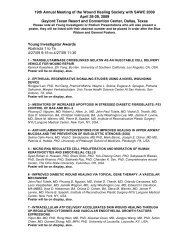

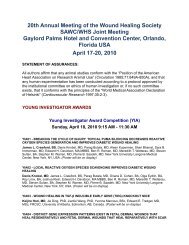
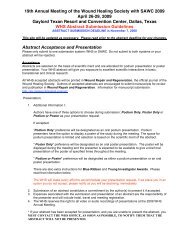
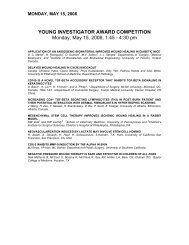



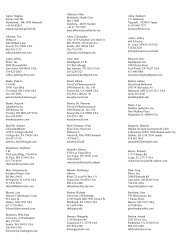
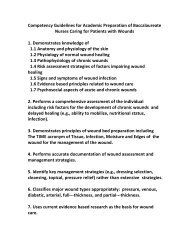
![2010 Abstracts-pah[2] - Wound Healing Society](https://img.yumpu.com/3748463/1/190x245/2010-abstracts-pah2-wound-healing-society.jpg?quality=85)